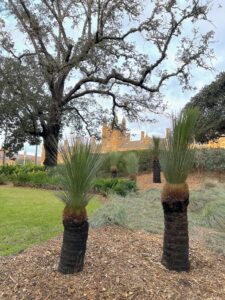DRAFT The work described here are best understood as invitations to connect with the botanical world, and in doing so, learn about the landscapes. Each project has brought together people from across the university in interesting ways.
CampusFlora started as a second year “students-as-partners” project to map the gymnosperms on campus as a supplement to existing botany practical classes. CampusFlora maps and offers information about the plants on campus.
Curriculum Garden. A collaboration
Environmental Heritage Assessments at Narrabri and Camden.
Plantings for Public Art > jujuma
Completing the plantings at CCWM ceremonial space
 To mark the start of NAIDOC Week activities at the University of Sydney, Sydney Environment Institute Deputy Director Rosanne Quinnell spoke at the Aboriginal flag raising ceremony on Monday, 3 July 2023 to introduce a series of new Gadi trees at the Chau Chak Wing Museum. Below is an edited version of her speech.
To mark the start of NAIDOC Week activities at the University of Sydney, Sydney Environment Institute Deputy Director Rosanne Quinnell spoke at the Aboriginal flag raising ceremony on Monday, 3 July 2023 to introduce a series of new Gadi trees at the Chau Chak Wing Museum. Below is an edited version of her speech.
“Good morning, everyone.
Thanks to Deputy Vice Chancellor Indigenous Strategy and Services (DVC ISS) for this opportunity to speak at the flag raising ceremony to mark the start of NAIDOC week activities on campus.
First and foremost, I offer my deepest respects to the Traditional Custodians of the land where we gather this morning as we celebrate NAIDOC Week – the Gadigal people. I pay my respects to the Elders past, present and emerging.
This morning I offer a very special introduction to some very special Gadis – or grass trees. “Gadi” is the Sydney Language name for the grass tree, which, pre-invasion, dominated the Sydney coastline. We are all responsible for revitalising language and learning the names of living things in the Sydney Language.
These Gadis are important for a number of reasons. These gadis extend the signature “Gadi plantings” of the University, all of which are expressions of the Walanga Wingara Mura Design Principles, which offer the means through which Aboriginal and non-Aboriginal members of the University can appreciate and experience the cultural connection First Nations people have with the botanical world.
This human-plant relationship positions plants as teachers and Earth kin and has been recognised across this continent for 65,000 years. As a non-Aboriginal person, my thinking about the critical relationships that humans have with plants has been consolidated by rich discussions with Elders, to whom I am grateful.
The specific location where these Gadis have been placed, and where we will be moving to shortly, is the ceremonial space of the Chau Chak Wing Museum (CCWM), and their placement here completes the Museum’s landscaping vision. The ceremonial space is collective space as defined by Walanga Wingara Mura Design Principles where “relationships between different academic communities that constitute the University can be part of a network for collaboration and accountability for the good of the institution”.
In this instance the different communities were not limited to academic communities and included: DVC ISS, the Chancellor’s committee, the Grounds Staff, and researchers in Faculty of Science and the CCWM.
As we welcome these Gadis to campus I offer my sincerest thanks to the Chancellor’s committee for recognising the importance of this project and for funding the purchase of the Gadis, my colleagues at the CCWM, Jude Philp and the former Director, David Ellis, and the Grounds Staff headed up by Rachel Gale.”

